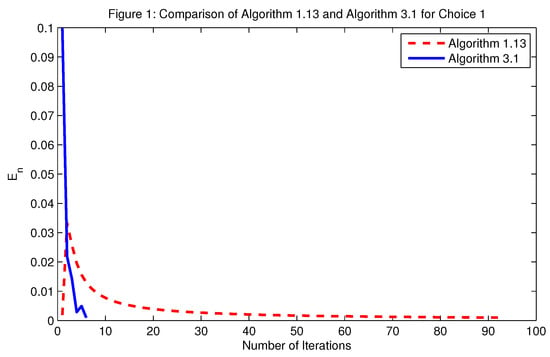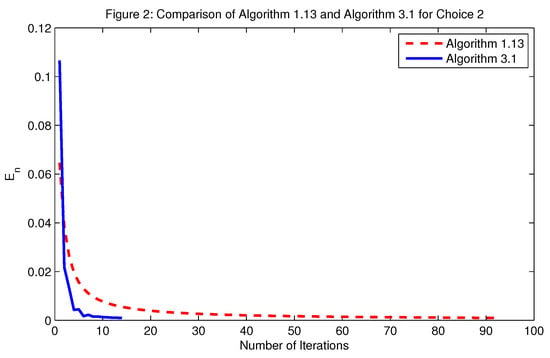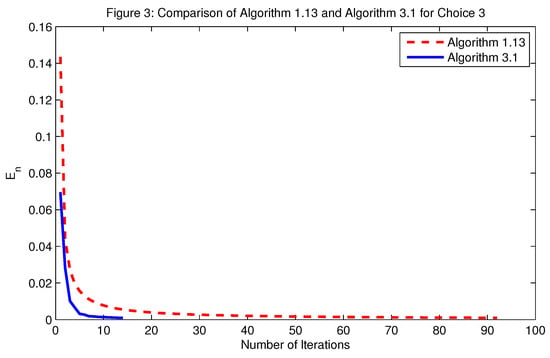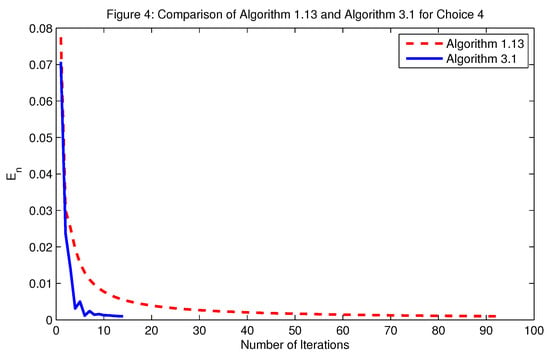Abstract
In this work, we study the inclusion problem of the sum of two monotone operators and the fixed-point problem of nonexpansive mappings in Hilbert spaces. We prove the weak and strong convergence theorems under some weakened conditions. Some numerical experiments are also given to support our main theorem.
1. Introduction
Let H be a real Hilbert space. We study the following inclusion problem: find such that
where is an operator and is a set-valued operator.
If and , where is the gradient of F and G is the subdifferential of G which is defined by
Then problem (1) becomes the following minimization problem:
To solve the inclusion problem via fixed-point theory, let us define, for , the mapping as follows:
It is known that solutions of the inclusion problem involving A and B can be characterized via the fixed-point equation:
which suggests the following iteration process: and
where .
Xu [1] and Kamimura-Takahashi [2] introduced the following inexact iteration process: and
where and Strong convergence was proved under some mild conditions. This scheme was also investigated subsequently by [3,4,5] with different conditions. In [6], Yao-Noor proposed the generalized version of the scheme (6) as follows: and
where with and The strong convergence is discussed with some suitable conditions. Recently, Wang-Cui [7] also studied the contraction-proximal point algorithm (7) by the relaxed conditions on parameters: and either or
Takahashi et al. [8] introduced the following Halpern-type iteration process: and
where A is an -inverse strongly monotone operator on H and B is a maximal monotone operator on H. They proved that defined by (8) strongly converges to zeroes of if the following conditions hold:
- (i)
- (ii)
- (iii)
- (iv)
Takahashi et al. [8] also studied the following iterative scheme: and
where and . They proved that defined by (9) strongly converges to zeroes of if the following conditions hold:
- (i)
- (ii)
- (iii)
- (iv)
There have been, in the literature, many methods constructed to solve the inclusion problem for maximal monotone operators in Hilbert or Banach spaces; see, for examples, in [9,10,11].
Let C be a nonempty, closed, and convex subset in a Hilbert space H and let T be a nonexpansive mapping of C into itself, that is,
for all . We denote by the set of fixed points of T.
The iteration procedure of Mann’s type for approximating fixed points of a nonexpansive mapping T is the following: and
where is a sequence in .
On the other hand, the iteration procedure of Halpern’s type is the following: and
where is a sequence in .
Recently, Takahashi et al. [12] proved the following theorem for solving the inclusion problem and the fixed-point problem of nonexpansive mappings.
Theorem 1.
[12] Let C be a closed and convex subset of a real Hilbert space H. Let A be an α-inverse strongly monotone mapping of C into H and let B be a maximal monotone operator on H such that the domain of B is included in C. Let be the resolvent of B for and let T be a nonexpansive mapping of C into itself such that . Let and let be a sequence generated by
for all , where and satisfy
.
Then converges strongly to a point of .
In this paper, motivated by Takahashi et al. [13] and Halpern [14], we introduce an iteration of finding a common point of the set of fixed points of nonexpansive mappings and the set of inclusion problems for inverse strongly monotone mappings and maximal monotone operators by using the inertial technique (see, [15,16]). We then prove strong and weak convergence theorems under suitable conditions. Finally, we provide some numerical examples to support our iterative methods.
2. Preliminaries
In this section, we provide some basic concepts, definitions, and lemmas which will be used in the sequel. Let H be a real Hilbert space with inner product and norm . When is a sequence in H, implies that converges weakly to x and means the strong convergence. In a real Hilbert space, we have
for all and
We know the following Opial’s condition:
if and .
Let C be a nonempty, closed, and convex subset of a Hilbert space H. The nearest point projection of H onto C is denoted by , that is, for all and . The operator is called the metric projection of H onto C. We know that the metric projection is firmly nonexpansive, for all
or equivalently
It is well known that is characterized by the inequality, for all and
In a real Hilbert space H, we have the following equality:
and the subdifferential inequality
for all .
Let . A mapping is said to be -inverse strongly monotone iff
for all .
A mapping is said to be a contraction if there exists such that
for all .
Let B be a mapping of H into . The effective domain of B is denoted by , that is, . A multi-valued mapping B is said to be a monotone operator on H iff for all , and . A monotone operator B on H is said to be maximal iff its graph is not strictly contained in the graph of any other monotone operator on H. For a maximal monotone operator B on H and we define a single-valued operator , which is called the resolvent of B for r.
Lemma 1.
[17] Let and be sequences of nonnegative real numbers such that
where is a sequence in and is a real sequence. Assume Then the following results hold:
- (i)
- If for some then is a bounded sequence.
- (ii)
- If and then
Lemma 2.
[17] Let be a sequence of real numbers that does not decrease at infinity in the sense that there exists a subsequence of which satisfies for all . Define the sequence of integers as follows:
where such that . Then, the following hold:
- (i)
- and ,
- (ii)
- and .
Lemma 3.
[18] Let H be a Hilbert space and a sequence in H such that there exists a nonempty set satisfying:
- (i)
- For every , exists.
- (ii)
- Any weak cluster point of belongs to S.
Then, there exists such that weakly converges to .
Lemma 4.
[18] Let and verify:
- (i)
- ,
- (ii)
- ,
- (iii)
- .
Then is a converging sequence and , where .
3. Strong Convergence Theorem
In this section, we are now ready to prove the strong convergence theorem in Hilbert spaces.
Theorem 2.
Let C be a nonempty, closed, and convex subset of a real Hilbert space H. Let A be an α-inverse strongly monotone mapping of H into itself and let B be a maximal monotone operator on H such that the domain of B is included in C. Let be the resolvent of B for and let S be a nonexpansive mapping of C into itself such that . Let be a contraction. Let and let be a sequence generated by
for all , where and , where satisfy
- (C1)
- and
- (C2)
- (C3)
- (C4)
Then converges strongly to a point of
Proof.
Let . Then for all . It follows that by the firm nonexpansivity of ,
By (C3), we obtain
On the other hand, since , it follows that
Let for all . Then we obtain
So, we have
By Lemma 1(i), we have that is bounded. We see that
We next estimate the following:
It follows that
We also have, using (19)
Set We next consider two cases.
Case 1: Suppose that there exists a natural number N such that for all . In this case, is convergent. From (34) we obtain
It follows that
Also, we obtain
We also have
Since , and converges, we have
and
as . We next show that as We see that
We also have
We next show that as . We see that
Since is bounded, we can choose a subsequence of which converges weakly to a point Suppose that . Then by Opial’s Condition we obtain
This is a contradiction. Hence . From , we have
From , we also have
This gives
So, we obtain
Since B is monotone, we have for
So, we have
which implies
Since and (since ), we have and thus . From (35), we have .
Since B is maximal monotone, we have Hence and thus we have .
We will show that Sine is bounded and , there exists a subsequence of such that
We know that
Since by Lemma 1(ii) So .
Case 2: Suppose that there exists a subsequence of the sequence such that for all . In this case, we define as in Lemma 2. Then, by Lemma 2, we have . We see that
From (34) we have
It follows that
We also have
We also have
We know that
From (36)–(38), we have
and Now repeating the argument of the proof in Case 1, we obtain . We note that
This gives
So This means Hence . It follows that
By Lemma 2, we have . Thus, we obtain
Hence and thus This completes the proof. □
Remark 1.
It is noted that the condition
is removed from Theorem TTT of Takahashi et al. [12].
Remark 2.
[17] We remark here that the conditions (C4) is easily implemented in numerical computation since the valued of is known before choosing . Indeed, the parameter can be chosen such that , where
where is a positive sequence such that .
4. Weak Convergence Theorem
In this section, we prove the weak convergence theorem.
Theorem 3.
Let C be a nonempty, closed, and convex subset of a real Hilbert space H. Let A be an α-inverse strongly monotone mapping of H into itself and let B be a maximal monotone operator on H such that the domain of B is included in C. Let be the resolvent of B for and let S be a nonexpansive mapping of C into itself such that . Let and let be a sequence generated by
for all , where and , where satisfy
- (C1)
- ;
- (C2)
- ;
- (C3)
- .
Then converges weakly to a point of .
Proof.
Let and . Then . From Theorem 2 we have
and
This shows that
By Lemma 4, we have converges. Thus, exists. So, by (44) we have
We also have
Moreover, we obtain
It follows that
.
By a similar proof as in Theorem 2, we can show that if there exists a subsequence of , such that , then . By Lemma 3, we conclude that weakly converges to a point in . We thus complete the proof. □
Remark 3.
[18] We remark here that the conditions (C3) is easily implemented in numerical computation. Indeed, once and are given, it is just sufficient to compute the update with (39) by choosing such that , where
where is such that .
5. Numerical Examples
In this section, we give some numerical experiments to show the efficiency and the comparison with other methods.
Example 1.
Solve the following minimization problem:
where and the fixed-point problem of defined by
For each , we set and . Put and in Theorem 2. We can check that F is convex and differentiable on with 2-Lipschitz continuous gradient. Moreover, G is convex and lower semi-continuous but not differentiable on . We know that for
We choose for all and For each let and define as in Remark 2. The stopping criterion is defined by
We now study the effect (in terms of convergence and the CPU time) and consider different choices of and as following, see Table 1.
- Choice 1: and ;
- Choice 2: and ;
- Choice 3: and ;
- Choice 4: and .
Author Contributions
N.P.; methodology, S.K.; write draft preparation and P.C.; supervision.
Funding
The authors would like to thank University of Phayao. P. Cholamjiak was supported by The Thailand Research Fund and University of Phayao under granted RSA6180084.
Conflicts of Interest
The authors declare no conflict of interest.
References
- Xu, H.K. A regularization method for the proximal point algorithm. J. Glob. Optim. 2006, 36, 115–125. [Google Scholar] [CrossRef]
- Kamimura, S.; Takahashi, W. Approximating solutions of maximal monotone operators in Hilbert spaces. J. Approx. Theory 2000, 106, 226–240. [Google Scholar] [CrossRef]
- Boikanyo, O.A.; Morosanu, G. A proximal point algorithm converging strongly for general errors. Optim. Lett. 2010, 4, 635–641. [Google Scholar] [CrossRef]
- Boikanyo, O.A.; Morosanu, G. Strong convergence of a proximal point algorithm with bounded errorsequence. Optim. Lett. 2013, 7, 415–420. [Google Scholar] [CrossRef]
- Marino, G.; Xu, H.K. Convergence of generalized proximal point algorithm. Commun. Pure Appl. Anal. 2004, 3, 791–808. [Google Scholar]
- Yao, Y.; Noor, M.A. On convergence criteria of generalized proximal point algorithms. J. Comput. Appl. Math. 2008, 217, 46–55. [Google Scholar] [CrossRef]
- Wang, F.; Cui, H. On the contraction-proximal point algorithms with multi-parameters. J. Glob. Optim. 2012, 54, 485–491. [Google Scholar] [CrossRef]
- Takahashi, W. Viscosity approximation methods for resolvents of accretive operators in Banach spaces. J. Fixed Point Theory Appl. 2007, 1, 135–147. [Google Scholar] [CrossRef]
- Combettes, P.L. Iterative construction of the resolvent of a sum of maximal monotone operators. J. Convex Anal. 2009, 16, 727–748. [Google Scholar]
- Lopez, G.; Martín-Márquez, V.; Wang, F.; Xu, H.K. Forward-Backward splitting methods for accretive operators in Banach spaces. Abstr. Appl. Anal. 2012, 2012, 109–236. [Google Scholar] [CrossRef]
- Lehdili, N.; Moudafi, A. Combining the proximal algorithm and Tikhonov regularization. Optimization 1996, 37, 239–252. [Google Scholar] [CrossRef]
- Takahashi, S.; Takahashi, W.; Toyoda, M. Strong convergence theorems for maximal monotone operators with nonlinear mappings in Hilbert spaces. J. Optim. Theory Appl. 2010, 147, 27–41. [Google Scholar] [CrossRef]
- Takahashi, W.; Tamura, T. Convergence theorems for a pair of nonexpansive mappings. J. Convex Anal. 1998, 5, 45–56. [Google Scholar]
- Halpern, B. Fixed points of nonexpanding maps. Bull. Am. Math. Soc. 1967, 73, 957–961. [Google Scholar] [CrossRef]
- Dong, Q.L.; Cho, Y.J.; Zhong, L.L.; Rassias, T.M. Inertial projection and contraction algorithms for variational inequalities. J. Glob. Optim. 2018, 70, 687–704. [Google Scholar] [CrossRef]
- Dong, Q.L.; Yuan, H.B.; Cho, Y.J.; Rassias, T.M. Modified inertial Mann algorithm and inertial CQ-algorithm for nonexpansive mappings. Optim. Lett. 2018, 12, 87–102. [Google Scholar] [CrossRef]
- Suantai, S.; Pholasa, N.; Cholamjiak, P. The modified inertial relaxed CQ algorithm for solving the split feasibility problems. J. Ind. Manag. Optim. 2018, 14, 1595–1615. [Google Scholar] [CrossRef]
- Maingé, P.E. Convergence theorems for inertial KM-type algorithms. J. Comput. Appl. Math. 2008, 219, 223–236. [Google Scholar] [CrossRef]
© 2019 by the authors. Licensee MDPI, Basel, Switzerland. This article is an open access article distributed under the terms and conditions of the Creative Commons Attribution (CC BY) license (http://creativecommons.org/licenses/by/4.0/).




